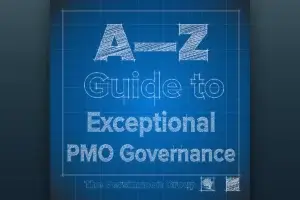If your strategy sounds like a corporate mission generator had a panic attack, it might be time to rewrite it.
If you stopped your team in the hallway and asked them to describe your strategy, what would you hear? A confident answer? A panicked reach for a PowerPoint? Or a version so watered down it could describe any organization?
When a strategy isn’t repeatable, it isn’t executable. If your team can’t say it, they can’t align with it. And when they can’t align with it, they default to their own interpretations—pulling the organization in different directions.
So, how do we end up with strategies that no one can remember? The ones packed with so many buzzwords, clauses, and competing priorities that they sound engineered for maximum ambiguity?
Two words: Group Edit.
In an effort to include every stakeholder, every theme, and every aspiration, we end up with strategy statements that look like this:
If you stopped reading after two lines, you’re not alone.
Yet statements like this are published and pushed out across organizations all the time, often under the banner of strategic alignment. When leadership teams try to write by committee, they fall into a few predictable traps:
- Consensus by inclusion – Instead of choosing, they collect every idea, every theme, every keyword.
- Fear of omission –No one wants to be the person who suggested leaving out “innovation,” “inclusion,” or “resilience.”
- Polishing instead of pruning – The group spends hours finessing tone, but no one steps in to cut the clutter.
And when no one pushes back, the sentence doesn’t get better—it just gets longer, until it collapses under its own weight.
To be clear, the issue isn’t necessarily the number of people in the room. In fact, diverse perspectives are essential for building strategy that works in the real world. But without structure and challenge in the process, diversity of input can morph into diffusion of focus.
Too often, we default to consensus as the goal, instead of clarity. We assume that if everyone’s language made it in, everyone’s aligned. But alignment isn’t about airtime. It’s about shared direction. And that requires choices.
What does a good strategic outcome look like?
It’s tempting to think the solution is just to simplify the language. But simplicity without substance doesn’t solve the problem; it just makes it shorter. A strong outcome statement does more than sound clean. It guides action.
Here’s what that looks like in practice:
- Your outcome is concrete. People can picture what success looks like. Not just in broad terms, but in their day-to-day work. It’s the difference between “drive innovation” and “Our customers consistently discover new features that make their jobs easier—month after month.”
- Your outcome is repeatable. It can be said out loud without a cheat sheet. If you want alignment, the outcome has to live outside the PowerPoint. Your team should be able to paraphrase it, believe it, and act on it—without worrying about getting the exact wording right.
- Your outcome is directional. It shows where the organization is going and what it’s prioritizing. It doesn’t just describe a future state—it helps people understand what to do more of, what to do less of, and what to stop entirely.
- Your outcome is prioritized. It reflects meaningful tradeoffs, not an attempt to be everything to everyone. It draws a line in the sand. When tough choices arise (and they always do), your outcome should act like a compass, not a collage.
Here are a few examples that pass the test:
“Our brand is synonymous with low-stress relocations for healthcare professionals—because we handle everything they don’t have time to think about.”
“Employees see this company as a place that invests in their growth—not just their productivity.”
“We’re the first call midsize retailers make when supply chain chaos hits—because we help them regain control faster than anyone else.”
Notice what’s missing? There’s no jargon, no vague gestures toward empowerment or ecosystems—just a precise, compelling outcome people can align around. Outcomes like this also help surface the goals and KPIs needed to achieve them more quickly.
How to Reduce “Strategy by Committee”
Overwritten outcome statements aren’t just a writing problem—they’re a process problem. When strategy becomes a group editing exercise, clarity gets traded for consensus. Everyone’s pet idea, favorite phrase, and unspoken agenda gets airtime, but no one makes the hard call to choose.
If you want a clearer outcome, you don’t just need a better sentence. You need a better way of working together.
Here’s how you (or a great facilitator) can help push back politics:
- Break it down:
- Ask: What is this really trying to say?
- Underline every buzzword—and challenge whether it adds clarity or just padding.
- Look for phrases that start with “and” or “while.” Those often signal an attempt to mash multiple ideas into one statement.
- Cut ruthlessly:
- Keep one idea per sentence, maximum.
- Strip out anything that doesn’t sharpen the vision or guide behavior.
- If a term like “ecosystem” stays in, be sure it’s grounded in real, shared meaning.
- Test it out loud:
- Can your team repeat it in a meeting without reading it?
- Would a new hire understand it on their first day?
Push each other to answer these questions regularly and honestly, both as the strategy is being written and as it is being finalized.
Strategic Clarity is a Leadership Imperative
The ability to produce a clear, compelling strategy isn’t a “nice to have” soft skill. It’s a core competency of leadership. It takes managerial courage to name what matters, make trade-offs visible, and resist the urge to please everyone with vague promises and bloated language.
And it doesn’t just depend on one bold leader. It takes a team committed to treating strategy not as a group artifact, but as a shared commitment to clarity, direction, and alignment.
Because, in the end, strategy doesn’t fail due to execution. It fails in translation.
Leaders who can articulate what matters—and do it simply—build organizations that can move.
Let’s Build a Strategy You Believe In
Whether you’re starting from scratch or adapting to change, our strategy consultants help you cut through complexity, align your teams, and move forward with confidence.
Ready to turn insight into impact? Talk to a Strategy Expert →










